When I told my German-Turkish flatmate in Zittau that I’d be stopping in Stuttgart for a long weekend, he looked at me as though I’d said I was heading to the moon for groceries. “Why?” he asked, a single eyebrow raised, his expression teetering between confusion and pity. Stuttgart, you see, isn’t exactly Germany’s darling.
He grew up not far from the city, and according to him, there’s nothing to see. That hit a nerve. Part curiosity, part stubbornness, and maybe a tiny urge to prove him wrong, I decided to go anyway.
What I found wasn’t Berlin’s grit, Munich’s polish, or Dresden’s history. It rained — nearly constantly — and I wouldn’t call it the most charming of German cities. But here’s the thing: Stuttgart does have something.
It’s an easy stopover. It’s good for a weekend. And while it may not wow you at every corner, it will surprise you in pockets — whether it’s the grandeur of Schlossplatz, the sleek beauty of a Porsche, or the warm mineral waters that bubble up through its spas.
So, is Stuttgart worth visiting? If you’re curious enough to look past the drizzle, I’d say yes — here’s how to make the most of it, complete with your obligatory “things to do in Stuttgart” list, because what’s a trip without one?
Disclosure: This article contains affiliate links. If you make a purchase through these links, I may earn a small commission at no extra cost to you. Thank you for supporting my blog!
Top Things to Do in Stuttgart
Stuttgart isn’t a city that shouts; it’s one that nudges. Its highlights are scattered — grand palaces here, car museums there, vineyards creeping into the edges — like it’s waiting to be quietly discovered.
If you’re willing to wander, Stuttgart will give you a handful of moments worth remembering.
Save this article for future reference!
1. Explore Stuttgart’s Palaces and Gardens
Start where most journeys through Stuttgart begin: Schlossplatz, the city’s elegant centrepiece and a magnet for locals, tourists, and confused pigeons alike.
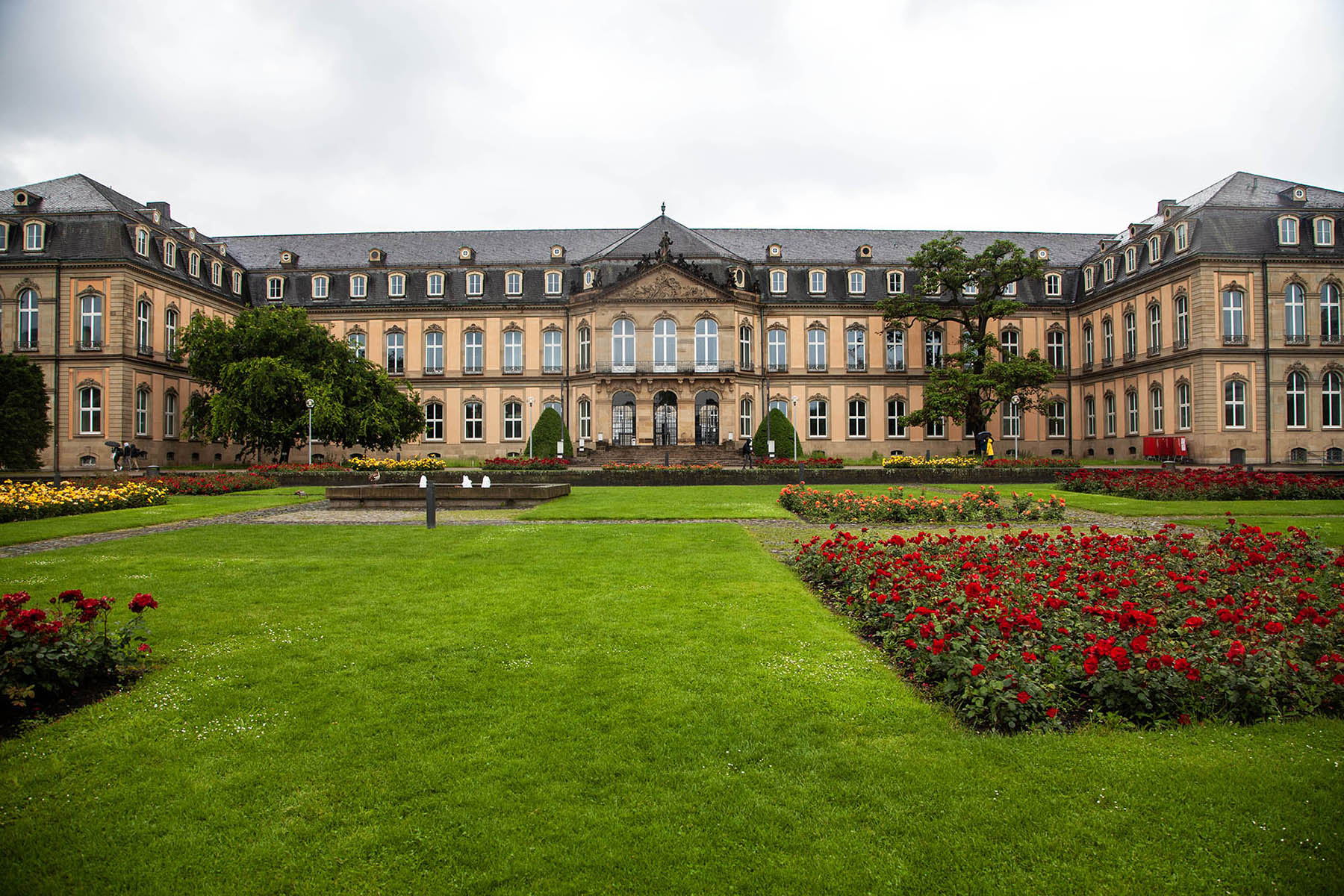
Surrounded by baroque grandeur, the New Palace (Neues Schloss) is as close as Stuttgart gets to feeling regal. Built in the 18th century, it once housed dukes and kings but now serves more as an architectural showstopper than a royal residence. Grab a bench, sip a coffee, and embrace the gentle chaos of people-watching — because on a sunny day, everyone ends up here.
Just behind the square, you’ll find the Middle Palace Garden, a surprisingly serene escape that feels miles away from the city buzz. It’s perfect for a morning stroll, a lazy picnic, or even a nap (rain permitting). Fun fact: Stuttgart has over 400 stairways winding through its hills, so these peaceful flat paths? A gift.
And then there’s the Old Castle (Altes Schloss), which looks like it leapt out of a medieval daydream. Parts of it date back to the 10th century, and while the inside houses the Württemberg State Museum, the exterior alone is worth a pause. If you’re short on time, simply walk the perimeter, admire its fortified walls and courtyard, and let yourself imagine knights or at least a really intense game of hide-and-seek.
Helpful Tip: This whole area is pedestrianised and explored on foot. Everything’s close together, and the gardens make for a great pause between sightseeing stops.
2. Stroll Königstraße
If Stuttgart had a red carpet, Königstraße would be it. Stretching for over a kilometre, this is the city’s main shopping street — a lively, pedestrian-only boulevard where locals run errands, tourists wander aimlessly, and buskers compete for your loose change.
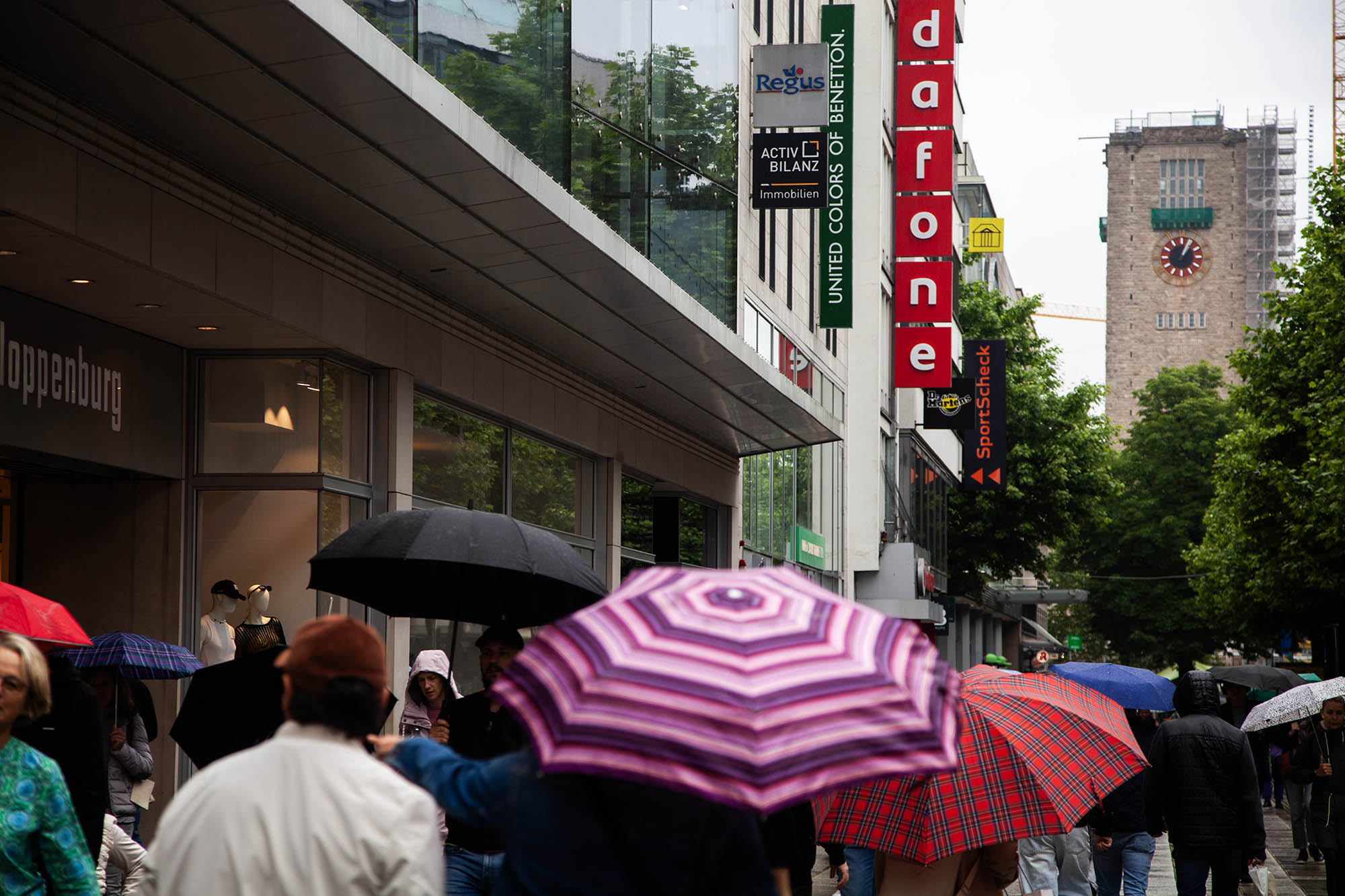
It’s the place to go if you want to people-watch, grab a snack, or, let’s be honest, succumb to the gravitational pull of international chains and window displays.
While Königstraße is unapologetically modern, don’t let the shiny storefronts fool you. Look up, and you’ll spot architectural gems, like the clock tower of the nearby Stiftskirche (#4, below), peeking out between shops. It’s a mix of the old and new, much like Stuttgart itself.
Insider Tip: If you’re hungry, grab a fresh pretzel (Brezel) or pastry from one of the many bakeries — Stuttgart is in Swabia, after all, and bread here is a minor art form. Don’t overthink it; just eat as you stroll.
Königstraße doesn’t pretend to be glamorous or historic — it’s functional, fun, and easygoing. Think of it as Stuttgart’s version of a pulse: always moving, always alive, and the perfect place to pause, browse, or let your feet take you wherever they please.
3. Discover the Markthalle Stuttgart
If Königstraße is Stuttgart’s pulse, Markthalle is its beating heart — just one lined with fresh produce, spices, and a dangerously tempting array of cheese. Housed in a stunning Art Nouveau building from 1914, this indoor market is a sensory overload in the best possible way.
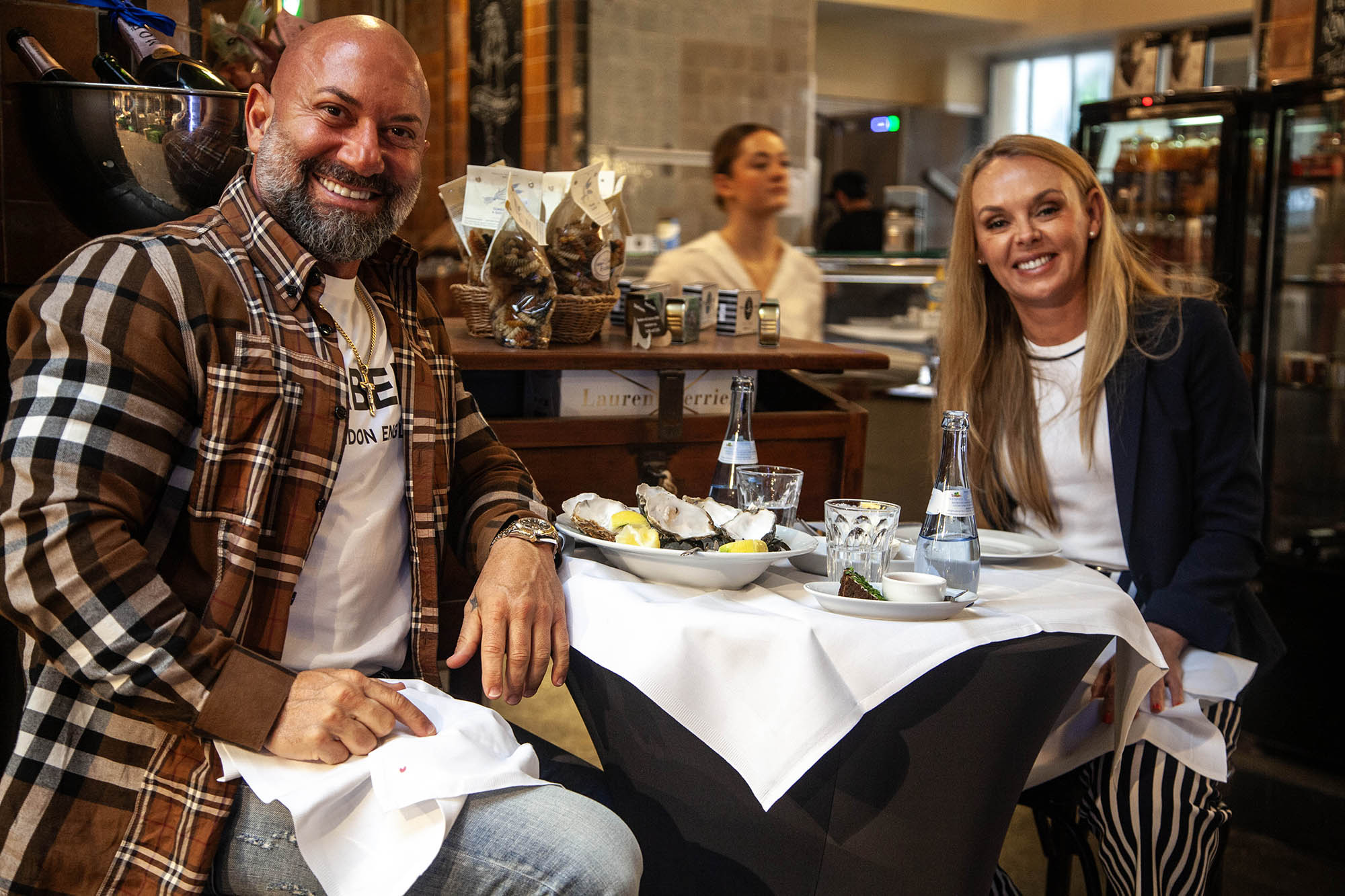
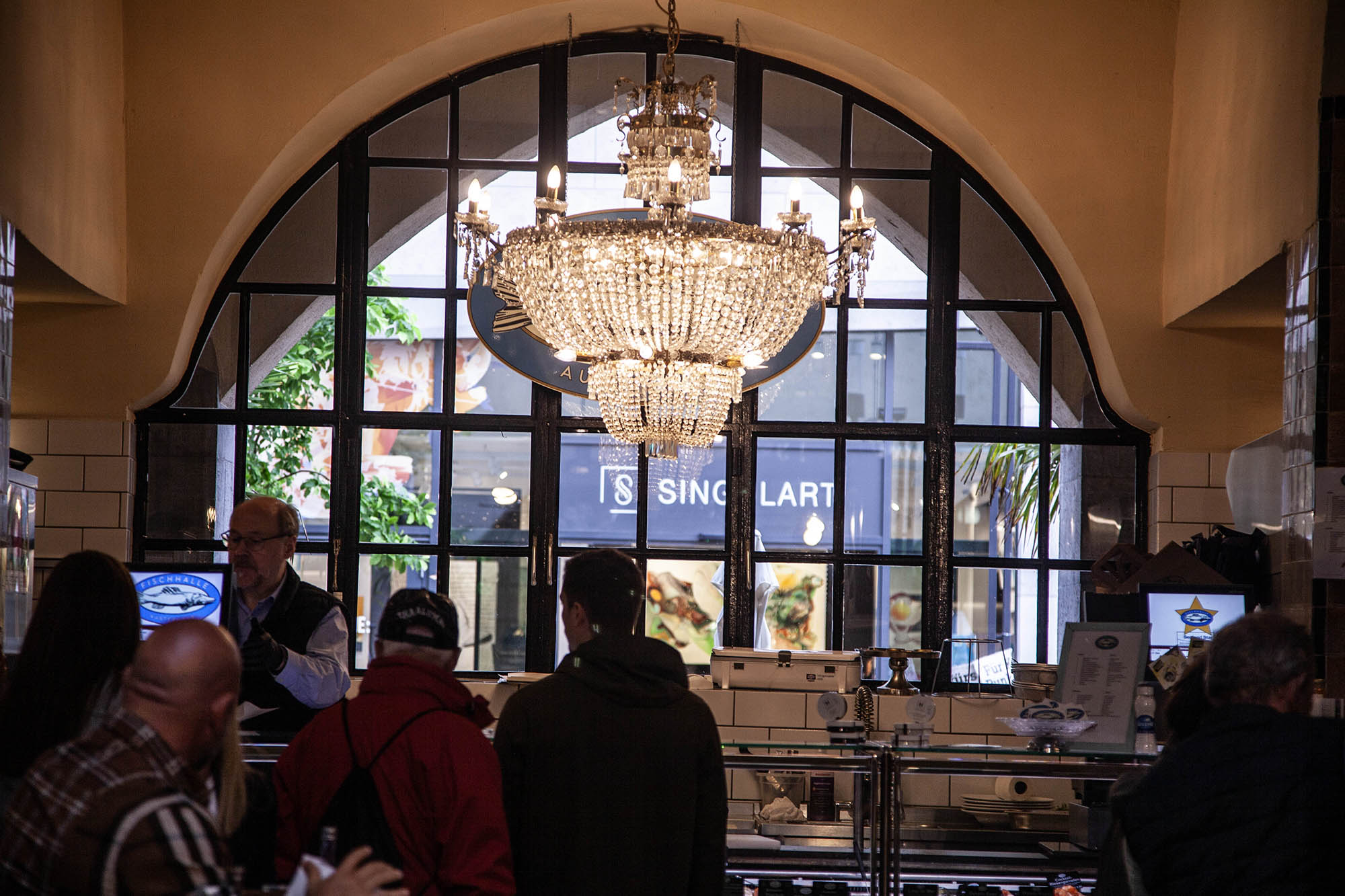
The moment I stepped inside (out of the pouring rain), I was greeted by the mingling scents of herbs, cured meats, and baked goods, as vendors chatted and locals shuffled through with baskets in tow.
Stuttgart’s Markthalle isn’t just for foodies — it’s for anyone who appreciates the theatre of daily life. You’ll find everything here: local Swabian specialties, Mediterranean olive oils, Moroccan spices, French pastries, and more sausages than you thought possible. Even if you’re not planning to buy, wandering the stalls feels like a mini-world tour.
Pro Tip: Don’t leave without grabbing a snack. Whether it’s a fresh-baked Brezel, a slice of cheese from one of the artisan counters, or a juicy fig that’s been plucked from a mountain of fruit, the small indulgences are what make Markthalle special.
And the best part? It’s beautiful. Look up at the intricate ironwork, the soft natural light pouring in through the windows, and the sprawling mezzanine above — it’s as much an architectural experience as it is a culinary one.
Helpful Tip: Visit in the late morning when it’s lively but not overwhelming. And if you’re in the mood to splurge, the mezzanine hosts a wine shop and delicatessen that’ll happily part you from your Euros.
4. Visit Schillerplatz and Stiftskirche
If Stuttgart’s palaces are its showstoppers, Schillerplatz is its quiet corner — small, charming, and soaked in history.
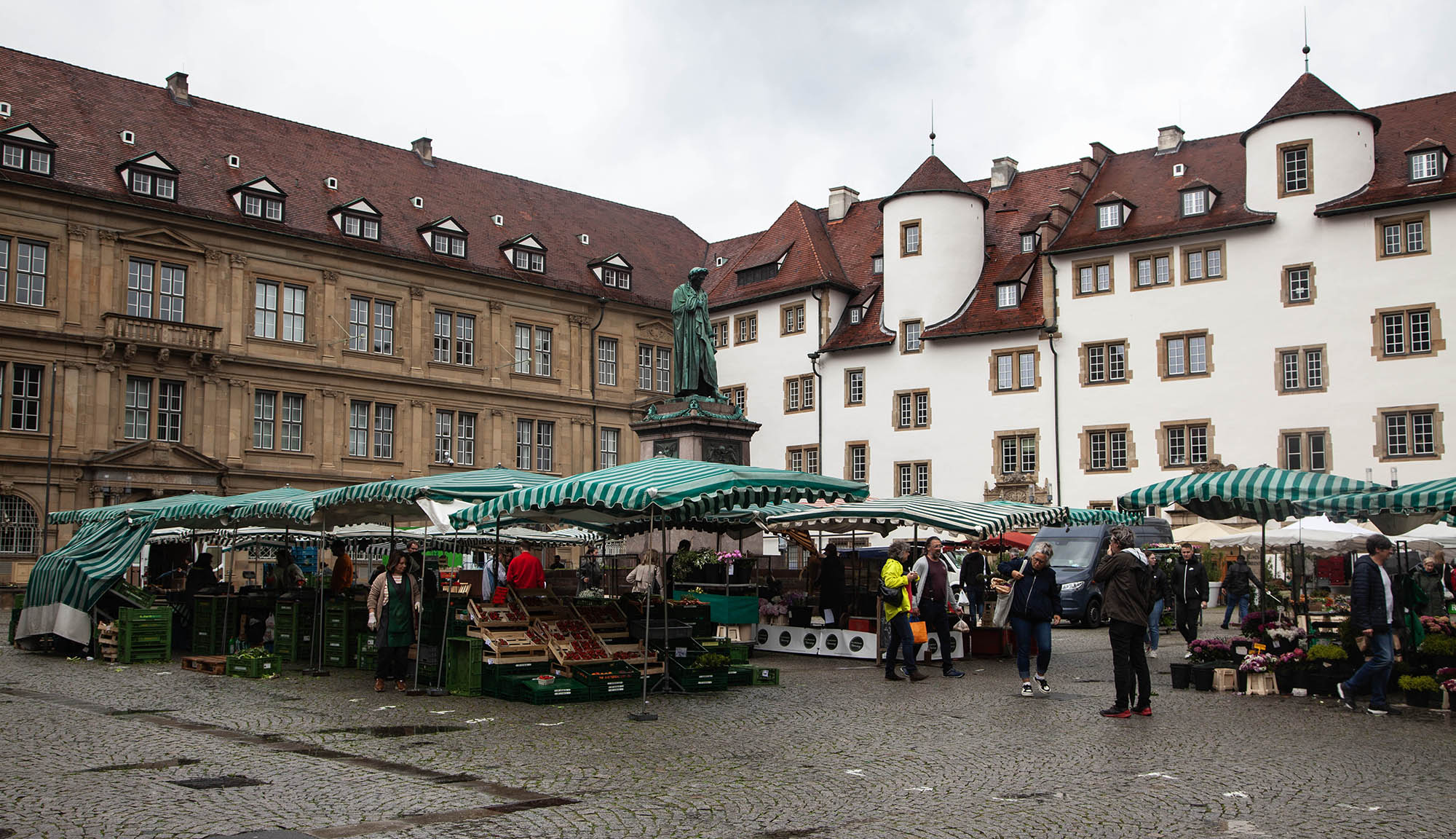
Named after Friedrich Schiller, one of Germany’s literary greats, the square feels like a scene from another century.
Cobblestones underfoot, historic buildings framing the edges, and the Schiller Monument at its centre — it’s the kind of place that quietly demands you pause for a moment. And I did. Standing there in the drizzle, I imagined Schiller himself brooding under the grey skies, probably as unimpressed by Stuttgart’s weather as I was.
Nearby, you’ll find the Stiftskirche, Stuttgart’s oldest church, whose twin towers dominate the skyline. It’s beautiful in that slightly mismatched way only a building with centuries of history can be, part Romanesque, part Gothic, part “whatever survived the war.” Step inside, and you’ll find stained glass and an almost eerie calm — a stark contrast to Königstraße’s bustle just a stone’s throw away.
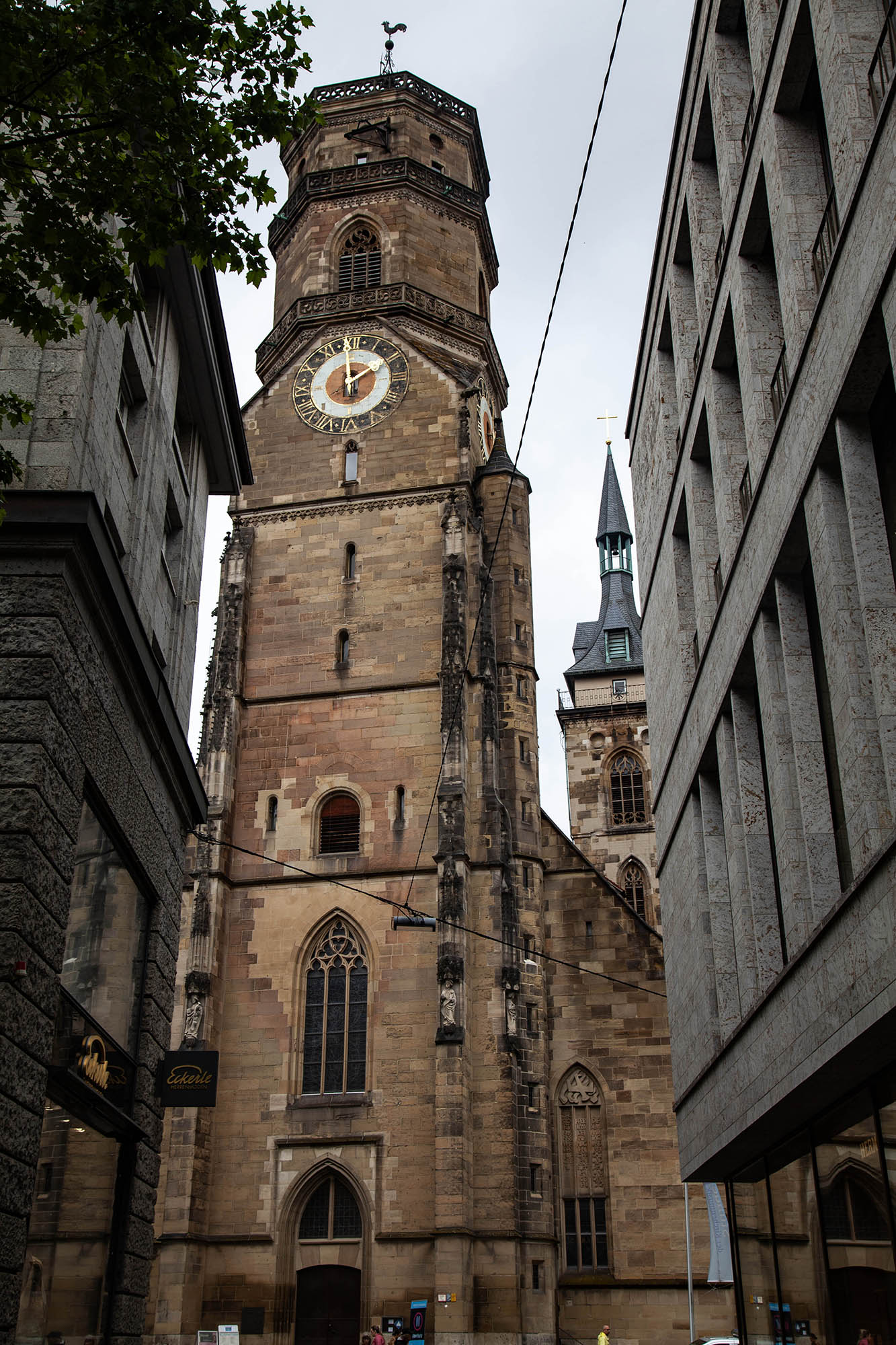
Pro Tip: If you visit on a Saturday, as I did, the square hosts a weekly flower market, which softens the scene with splashes of colour and the occasional whiff of fresh blooms. It’s simple, local, and lovely — everything Stuttgart does best.
Schillerplatz isn’t the kind of place that screams for attention, but that’s what makes it memorable. It’s understated, a little moody, and if you let it, it’ll quietly work its way under your skin.
5. Kunstmuseum Stuttgart
I didn’t actually go inside the Kunstmuseum Stuttgart — a choice based less on time and more on my wallet. The building itself, though, is a work of art: a glass cube that glows beautifully in the evening, housing a striking collection of contemporary and modern pieces.
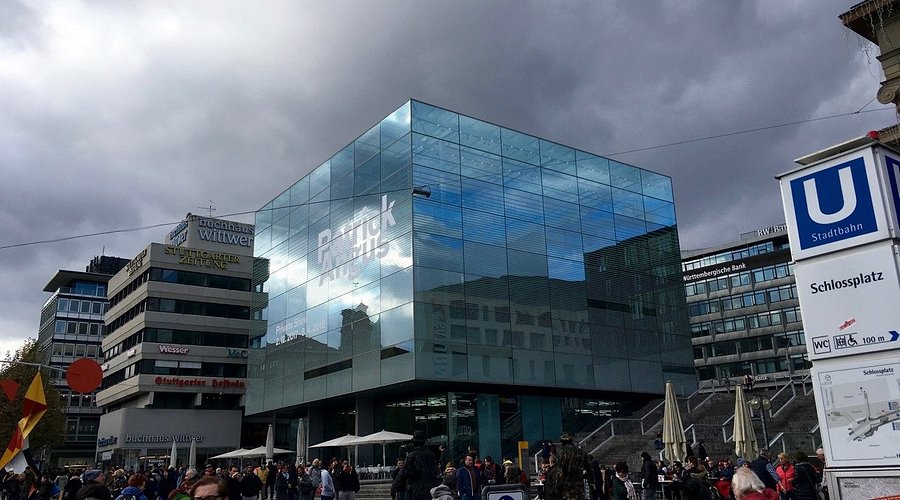
What I did get was a recommendation. A German guy from my hostel dorm — who I ended up chatting with for hours — insisted it was worth every cent. He talked about the standout works by Otto Dix, the thought-provoking exhibitions, and how it was one of the best modern art museums he’d seen.
It wasn’t just the art we talked about, though; we wandered into stories of travel, home, family, philosophy, and the odd quirks of Stuttgart. We’ve kept in touch since, and it reminded me of one simple truth about travel: sometimes the best connections aren’t with the places, but the people you meet along the way.
So if you’re into modern art — or even if you just want to admire the architecture — add the Kunstmuseum to your list. It’s bold, sharp-edged, and hard to miss, standing in stark contrast to the old-world charm of nearby Schillerplatz.
Pro Tip: Visit in the evening when the building is illuminated — it’s free to admire from the outside, and the glow against Stuttgart’s centre is special.
Want to discover Stuttgart like a local? Stuttgart is full of surprises, and sometimes the best way to uncover them is with someone who knows the city inside and out. If you're looking to dive deeper into its art, why not explore with a local? A guided experience can transform your visit into something truly memorable.
Check out this art and culture tour of Stuttgart for a different take on the city.
6. Staatsgalerie Stuttgart (Stuttgart State Gallery)
I skipped the Staatsgalerie Stuttgart, which in hindsight seems ridiculous — what better refuge is there than a museum when it’s raining non-stop? But with my budget already stretched, I was saving my pennies for the Mercedes-Benz Museum (#9 below, which set me back a respectable 16 euros).
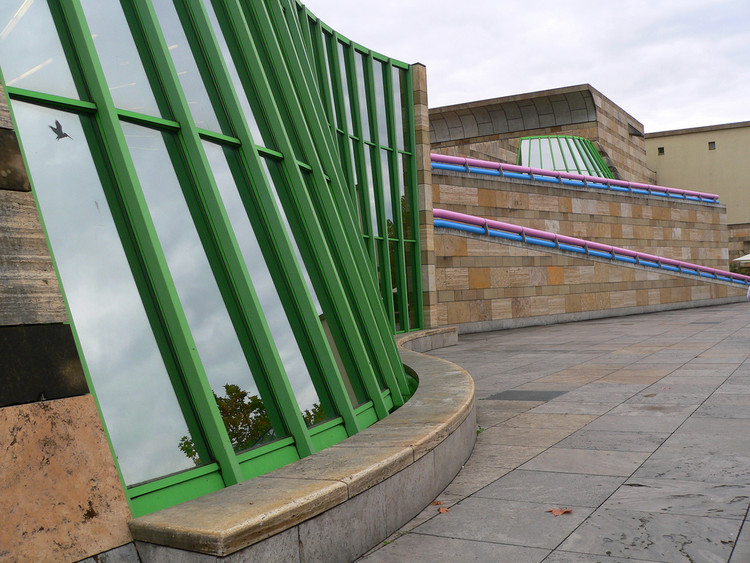
That said, the Staatsgalerie is one of Stuttgart’s cultural heavyweights.
Its bold pink-and-teal trimming is impossible to miss, blending neoclassical grandeur with modern quirks. Inside, the collection spans centuries: Rubens, Rembrandt, Picasso, and Matisse rub shoulders with contemporary works, making it a feast for art lovers. Even the museum itself feels like an artwork, with its bright, spiralling halls and a sculpture garden that spills into the outdoors.
If you’ve got the time and budget, it’s a must-visit. And if not, just swing by to admire the building — it’s free to stand in awe of good design.
Pro Tip: Entrance is discounted on certain days, and there’s a small cafe where you can escape the drizzle with a coffee and a view. Stuttgart may have its rainy moods, but at least it gives you good places to hide.
7. Wander the Bohnenviertel District
The Bohnenviertel District feels like a secret Stuttgart whispers to those willing to slow down and listen.
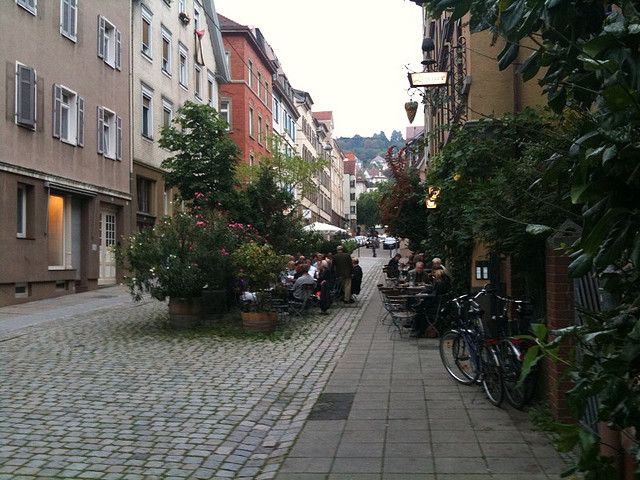
Tucked just off the city’s main streets, this is Stuttgart’s oldest neighbourhood, and it still hums with a quiet, bohemian charm. Think narrow cobblestone alleys, half-timbered houses, and a scattering of artisan shops, galleries, and cafes that seem happily untouched by time.
It’s not flashy or polished, but that’s the point. The Bohnenviertel is where you wander without a plan, ducking into quirky boutiques, stumbling on handmade treasures, or settling into a cafe with a strong coffee and a good book. When I wandered through, the drizzle made everything glisten — proof that sometimes rain can add a little magic.
Personal Tip: Take the time to chat with shopkeepers or cafe owners. One gallery owner I met was eager to share stories about the area, turning what could have been just a stroll into something memorable.
The Bohnenviertel is about moments. It’s where Stuttgart slows down.
8. Stuttgart Public Library
Stuttgart Public Library is like walking into a geometric dream. With its stark white interiors, symmetrical shelves, and minimalist design, it’s a space that feels more like an art installation than a library. Built in 2011, this modern marvel stands out from the moment you see its cube-shaped exterior, which glows softly in the evening.

Inside, the library is all about quiet grandeur. Every floor has its own unique charm, but the highlight is the atrium — a multi-level expanse of open space where books line the walls and light floods in from above.
Even if you’re not into libraries, it’s worth visiting just to soak in the atmosphere and snap a few envy-inducing photos.
I didn’t expect to spend much time here, but the tranquility was magnetic. It’s the kind of place where you find yourself lingering, flipping through random books, or just sitting in one of the cosy corners pretending to read while secretly people-watching.
Pro Tip: Admission is free, making it a perfect spot for budget travellers. If you’re visiting in the evening, don’t miss the rooftop terrace — it offers a unique perspective of Stuttgart.
The Stuttgart Public Library is proof that sometimes the most stunning places aren’t museums or palaces — they’re spaces designed for the everyday. And that’s what makes it great.
9. Dive Into the Mercedes-Benz Museum
Stuttgart is the birthplace of the automobile, so skipping the Mercedes-Benz Museum would be like ignoring the Eiffel Tower in Paris — it’s the thing to see.

Located a short train ride northeast of the city centre, this sleek, spiralling museum is a temple to innovation, design, and 130+ years of automotive history.
Even if you don’t care about cars, it’s hard not to be impressed by the storytelling here: a smooth descent through time, starting with the invention of the automobile and winding all the way to futuristic concepts and racing legends.
The space itself feels futuristic, too — nine floors of exhibits are laid out in a double-helix design, and every corner begs to be photographed.
My personal highlights? A jaw-dropping line-up of vintage cars, silver Formula 1 beauties that scream speed even when standing still, and the odd unexpected gem, like the Popemobile (yes, really).
Since you’re already out this way, make a cluster of it:
- Grabkapelle auf dem Württemberg (#10, below): Just a short ride further, this hilltop chapel offers sweeping vineyard views and a romantic backstory — built by King Wilhelm I in memory of his late wife.
- Stuttgart Pig Museum (#11, below): A quick stop nearby for something a little quirky. It’s the world’s largest collection of pig-themed art and oddities — fun, bizarre, and absolutely memorable.
Pro Tip: Tickets for the Mercedes-Benz Museum are 16 euros and well worth it. Plan to spend at least 2-3 hours here to take it all in. If you’re short on time, go early to beat the crowds.
Whether you’re a car buff or just a curious traveller, this place makes for a fascinating part of your day exploring some of Stuttgart’s northeastern corner.
10. Explore the Grabkapelle auf dem Württemberg
The Grabkapelle auf dem Württemberg is the kind of place that feels like Stuttgart’s reward for anyone willing to venture a little further afield. Perched on a hilltop northeast of the city centre, this neoclassical chapel looks out over sprawling vineyards and offers one of the best panoramic views you’ll find in Stuttgart.

Built by King Wilhelm I in the 1820s as a tribute to his late wife, Queen Katharina, it’s both a romantic gesture and a serene resting place. There’s something about the simplicity of the chapel — soft grey stone, elegant columns — that makes it even more moving, especially when paired with the sweeping scenery below.
Getting here requires a bit of effort — a train ride followed by a hillside walk — but that’s part of the charm. The trail winds through vineyards, and if you’re lucky, you’ll spot locals out for walks or tending the vines with baskets slung over their shoulders.
Pro Tip: Pack a small picnic (or some snacks you’ve gathered from Markthalle) and enjoy it on the hill while taking in the view. If you time it right, sunset here is unreal.
The Grabkapelle is beautiful on its own, but it’s also a quiet pocket of Stuttgart that gives you room to breathe, reflect, and take a pause — something every trip needs. If you’re exploring the Mercedes-Benz Museum (#9, above) or the Pig Museum (#11, below) nearby, this is the perfect place to end the day on a high note (literally).
11. Visit the Stuttgart Pig Museum
I’m not sure what you'd expect from the Stuttgart Pig Museum, but it probably isn't a sprawling celebration of all things pig — art, toys, sculptures, and curiosities — stuffed into every corner of a former slaughterhouse. Yes, really. As the world’s largest pig-themed museum, it takes quirky to a whole new level.
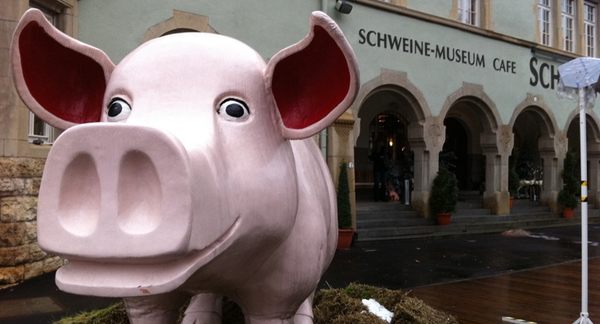
The collection is a bizarre and fascinating tribute to our curly-tailed friends, with over 50,000 exhibits covering everything from piggy banks and porcelain figurines to paintings and oddities you never knew existed. It's equal parts kitschy, charming, and downright weird — in the best possible way.
To be honest, you go for the novelty factor, but end up laughing at the absurdity of it all. There’s something undeniably fun about leaning into the ridiculous, and this place delivers that in spades.
Pro Tip: The museum is located near the Mercedes-Benz Museum (#9, above), so it’s easy to squeeze into the same day. Don’t miss the restaurant on-site either — it’s called Schlachthof (slaughterhouse), which feels a little on the nose, but it serves surprisingly good food.
If you’re the kind of traveller who enjoys the offbeat and unexpected, the Stuttgart Pig Museum is your spot. Where else are you going to find an entire room dedicated to piggy banks? Exactly.
12. Porsche Museum
If Stuttgart is the birthplace of the automobile, the Porsche Museum is where speed meets design in a perfectly polished tribute. Located northwest of the city centre in Zuffenhausen — Porsche’s hometown — this sleek, futuristic building is a temple to one of the world’s most iconic car brands.

The museum showcases over 80 vehicles, from the brand’s earliest models to legendary race cars and futuristic prototypes. Every car is pristine, every angle purposeful, and every exhibit feels engineered to inspire awe — even if you’re not a car enthusiast. Interactive displays and detailed timelines walk you through Porsche’s legacy of innovation, while the space itself — a striking, minimalist masterpiece — adds to the experience.
While it’s a bit of a trek from the city centre, the Porsche Museum draws visitors for one reason: Porsche. You go for the love of the brand, the history, and the thrill of seeing some of the world’s most beautiful machines up close.
Pro Tip: For true car fans, combine the Porsche Museum with the Mercedes-Benz Museum for the ultimate automotive day out. If you’re short on time, pick your favourite — because let’s be honest, even the most dedicated museum-goers have their limits.
13. Walk Weissenhofsiedlung (The Weissenhof Estate)
The Weissenhof Estate is a pilgrimage site for architecture lovers — modernist, minimalist, and unapologetically ahead of its time.
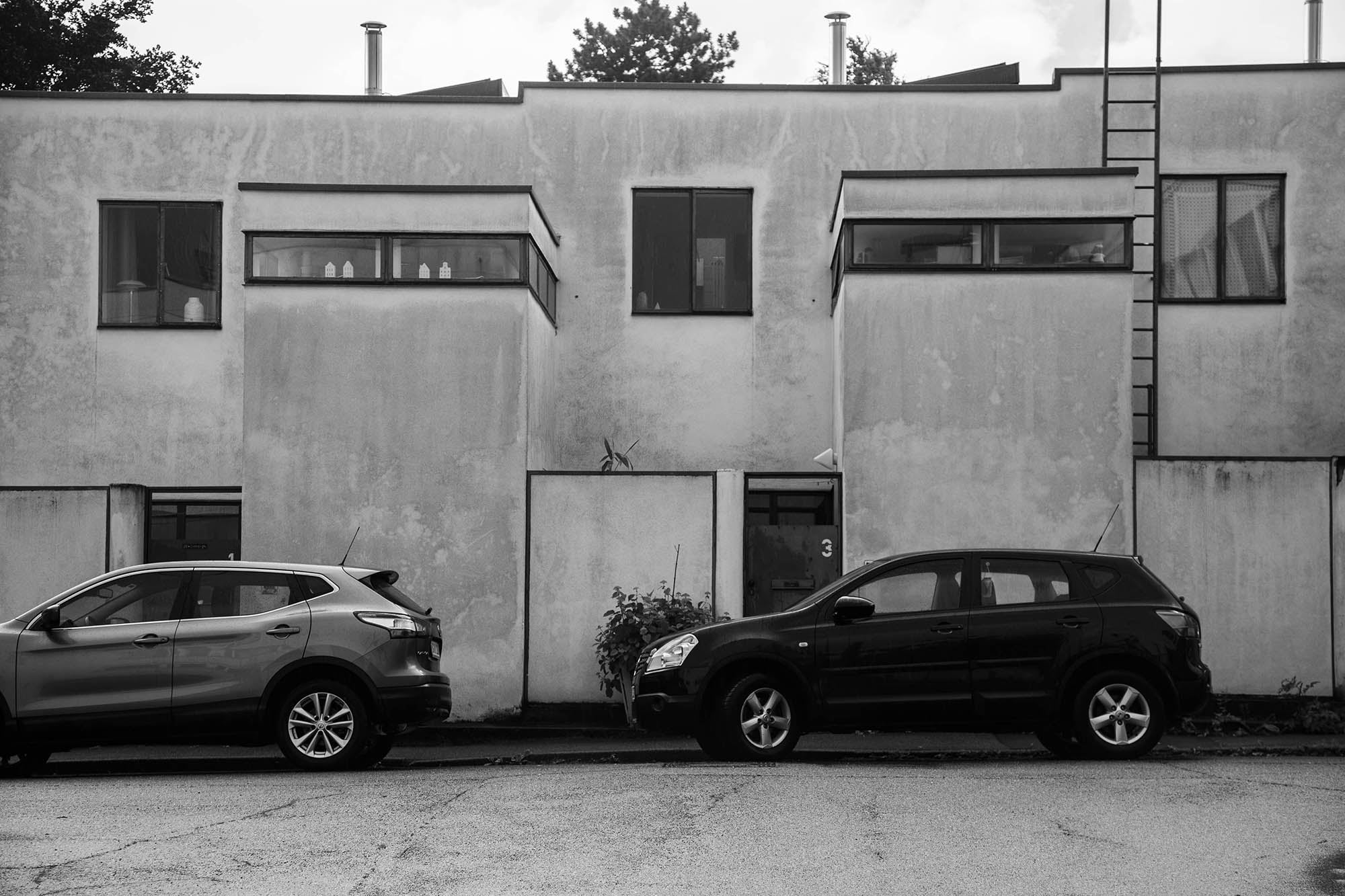
Built in 1927 as part of an experimental housing exhibition, this UNESCO-listed collection showcases work from Bauhaus pioneers, including Ludwig Mies van der Rohe and Le Corbusier. Clean lines, flat roofs, and functional design were radical concepts back then, and walking through the estate today feels like stepping into the future imagined almost a century ago.
Even in the rain, for me, it’s worth it — there’s something oddly fitting about the muted grey skies reflecting off the stark white facades. The cluster of houses is compact, easy to explore on foot, and comes with enough intriguing angles to keep photographers like me happy. While some buildings are private homes, the Weissenhof Museum offers a deeper dive into the estate’s history and vision (and also a dry place to linger if the weather takes a turn).
Pro Tip: If the drizzle turns into a downpour, there’s always the option to wait it out — Stuttgart’s bus shelters, conveniently placed nearby, offer a surprisingly decent vantage point for watching rain drip dramatically off those modernist rooftops. I sat for 20 minutes, patiently waiting, before moving on.
Pair this stop with Killesberg Park (#14, below), just a short walk away. Rain or shine, the Weissenhof Estate proves that good design stands the test of time — and weather.
14. Wander about Killesberg Park
If Stuttgart has a spot that feels like a breath of fresh air, it’s Killesberg Park — a sprawling green space that somehow balances manicured gardens with wild, open charm. It’s the kind of place where locals picnic, kids chase ducks, and, if you’re like me, visitors arrive soaking wet from a sudden downpour.
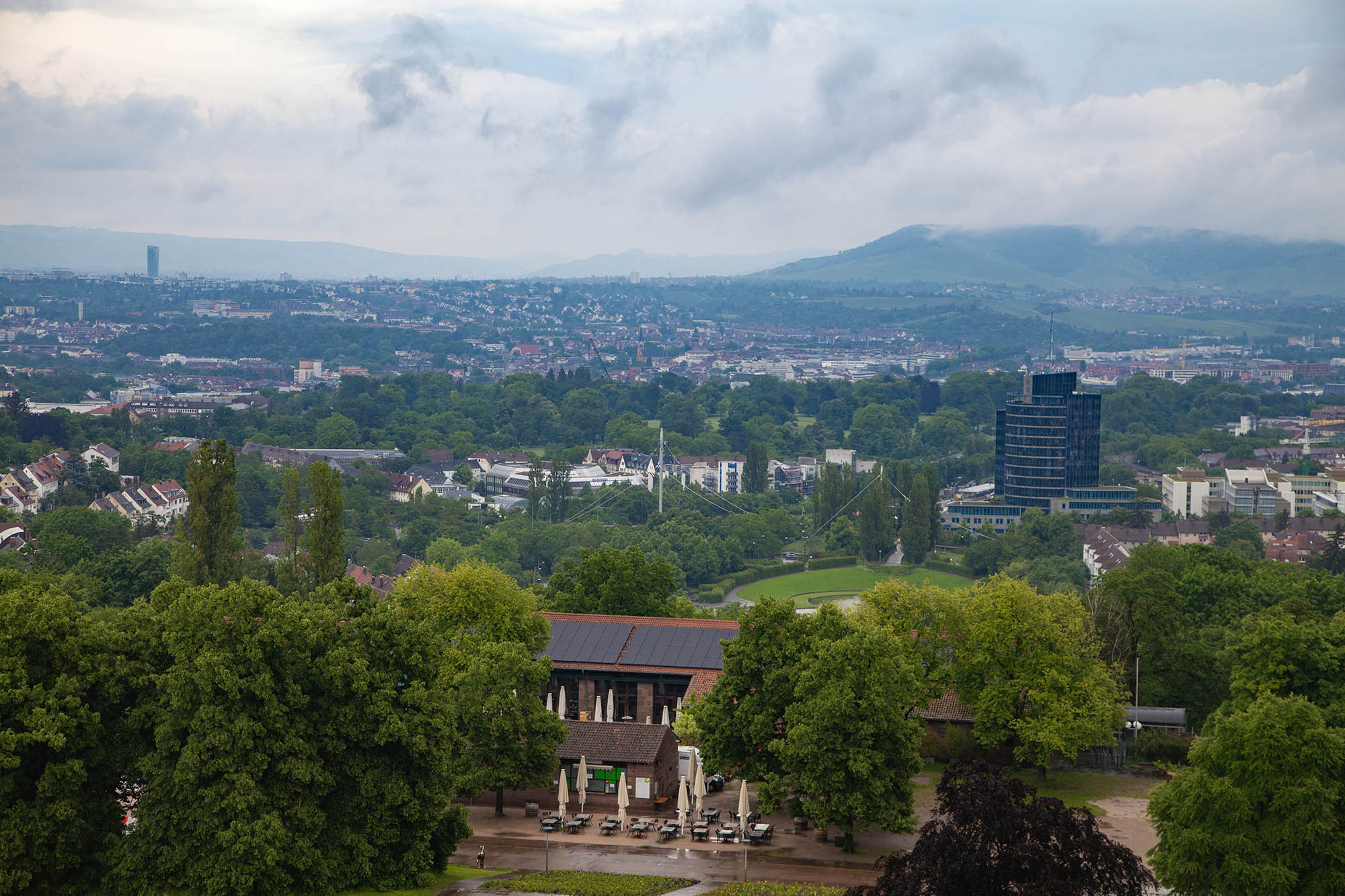
Once the skies cleared, I wandered the park’s paths, which twist through flower beds, water features, and wide-open lawns.
The highlight, quite literally, is the Killesberg Tower — a spiralling steel structure that offers panoramic views over the park and beyond. I made it partway up, but between the slippery steps and my fear of heights, I called it quits before reaching the top. (No shame—there’s bravery in knowing your limits.)
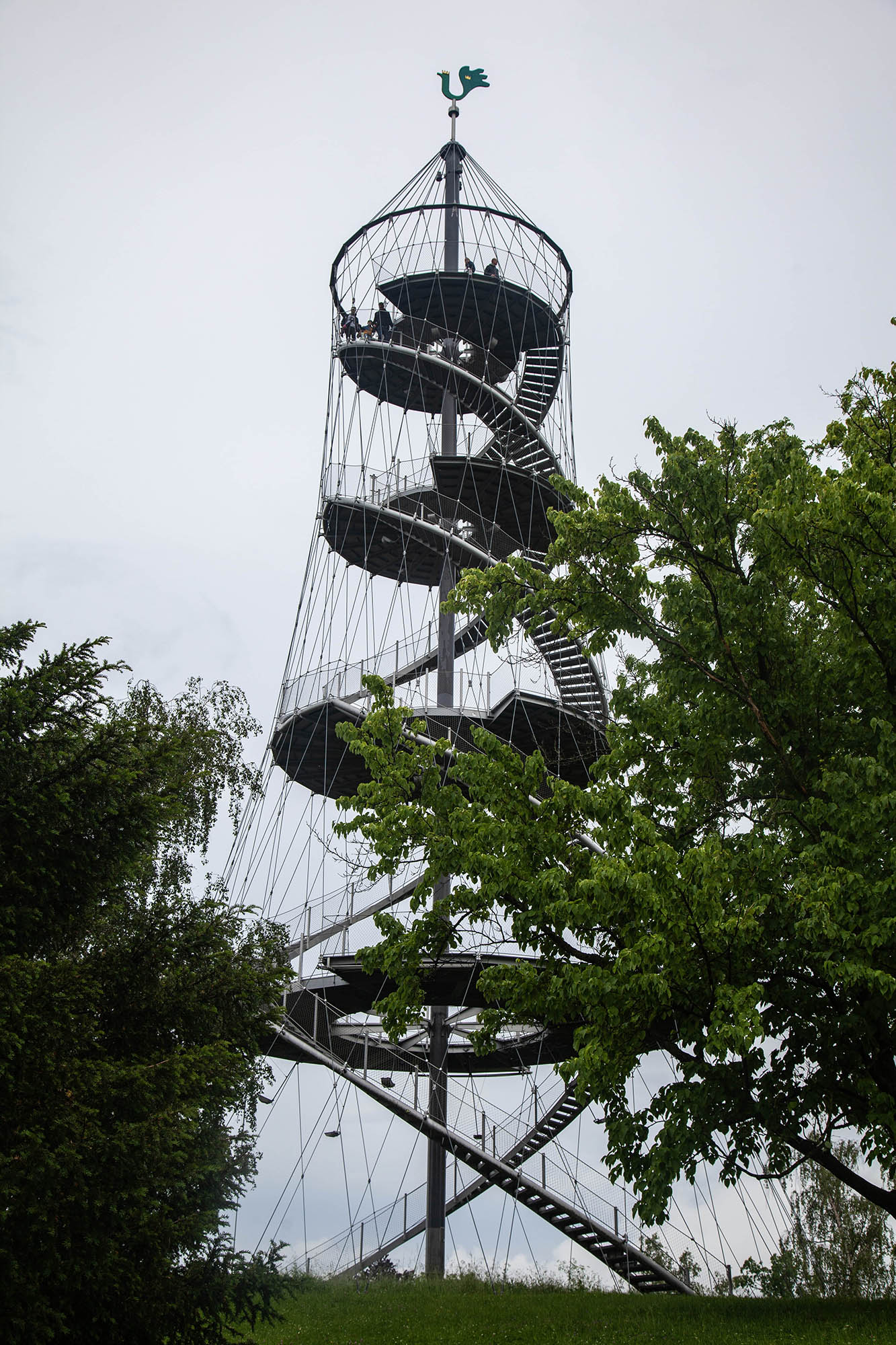
Instead, I retreated to the cosy Höhencafe Killesberg, where I found solace in a steaming cup of hot chocolate and a generous slice of cake. Watching the drizzle mist over the park’s edges while tucked away with dessert felt like an unexpected reward — proof that not all adventures have to involve great heights.
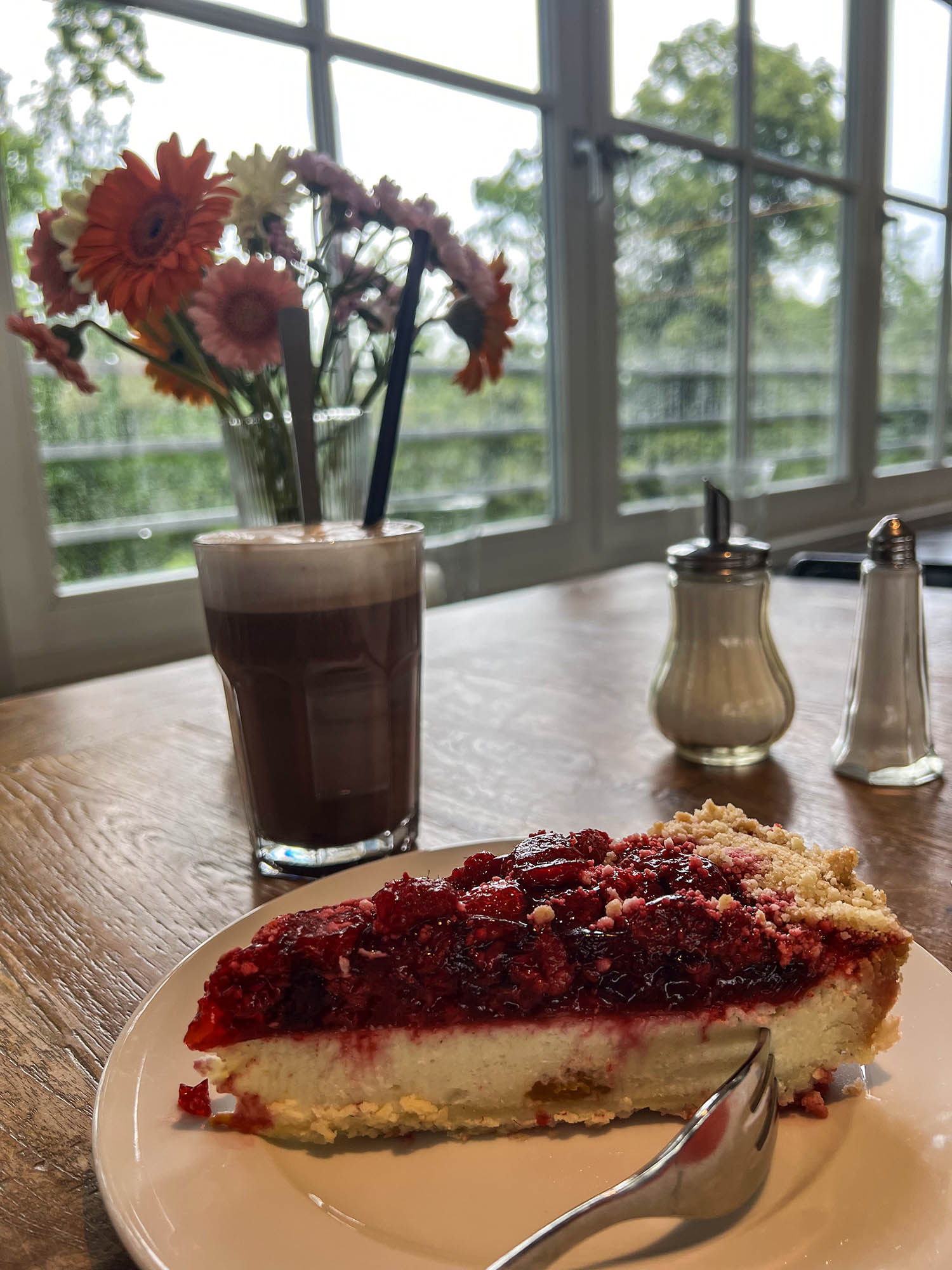
Pro Tip: Killesberg Park is lovely in any weather, but if you visit on a dry day, the views from the tower are worth pushing through your vertigo. If not, Höhencafe Killesberg is a worthy backup plan and a chance to slow down and soak in the park’s atmosphere.
Whether you’re walking the trails, climbing the tower, or just enjoying a quiet moment with cake, Killesberg Park is Stuttgart at its most easygoing.
15. Ride the Standseilbahn Stuttgart (Cable Car)
Tucked a little south of the city centre, the Standseilbahn Stuttgart is one of those charming outliers — a vintage cable car that feels like stepping back in time.
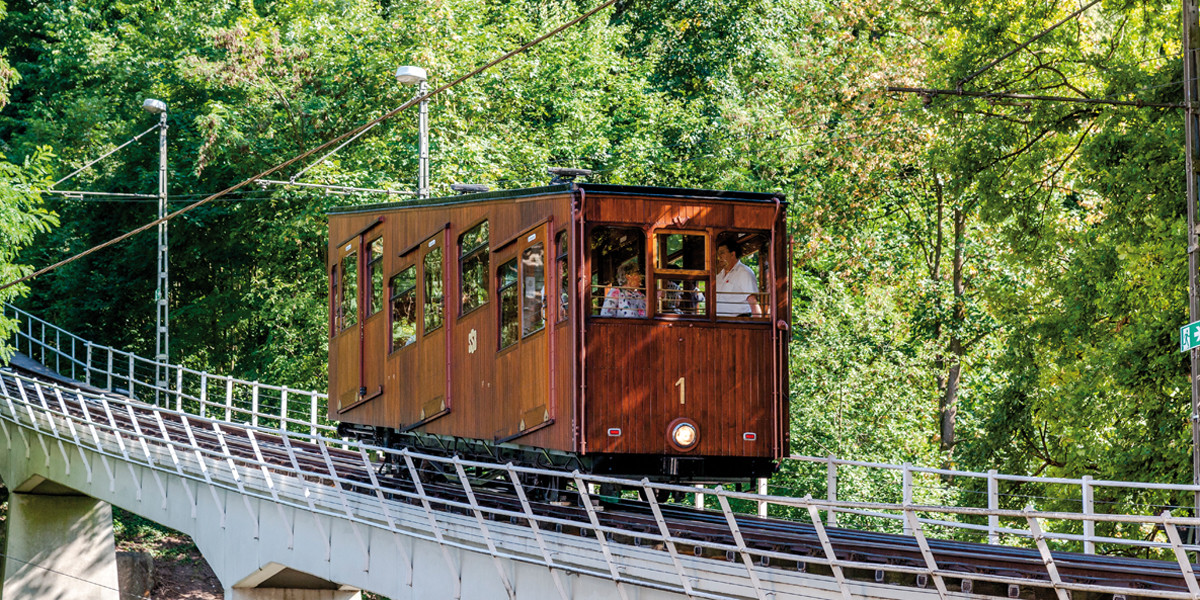
Built in the 1920s, it’s not just a means of transportation but a nostalgic experience, climbing through forested hills to the beautiful Degerloch cemetery. Yes, a cemetery. Odd, perhaps, but this is Stuttgart — where the unexpected has a habit of becoming delightful.
The wooden interior of the cable car, complete with brass details and a gentle clatter, has a quiet kind of magic. Along the way, the views open up through the trees, offering glimpses of the city from an angle most visitors miss. On a sunny day, it’s probably an easy highlight — a peaceful ride and a unique way to see a different side of the city.
Reality Check: I didn’t actually take the ride. The rain had other plans, and riding a cable car to nowhere in particular didn’t feel worth it in the moment. Still, for those with dry weather and a little extra time, the Standseilbahn is one of Stuttgart’s more unusual attractions — a short ride that’s equal parts history, charm, and scenery.
Pro Tip: Combine this with a walk through the nearby forest trails or stop by one of the area’s scenic viewpoints to make the most of the trip south. It’s not a must-see, but for fans of vintage charm, it’s a quiet little gem waiting to be discovered.
16. Discover Stuttgart’s Vineyards and Wine Tasting
Stuttgart’s vineyards are the city’s best-kept secret — rows of lush vines cascading down hillsides, hiding cosy wineries that produce some of Baden-Württemberg’s finest wines. The region is particularly known for Trollinger, Lemberger, and crisp Rieslings, perfect for tasting straight from the source.
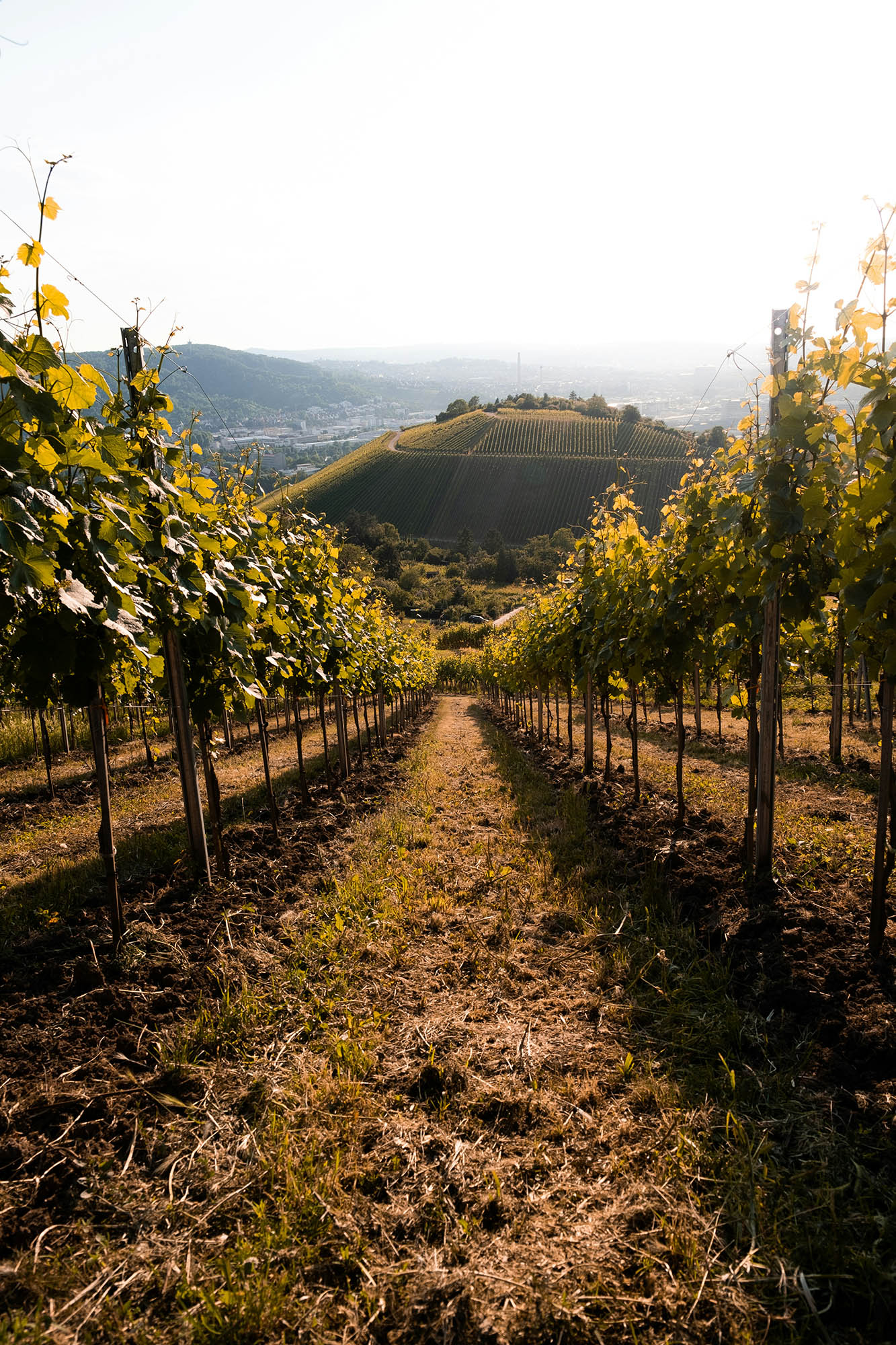
Note that some of the standout names are more polished estates or tasting rooms rather than bucolic hideaways. Still, they’re worth the visit for a glass (or two) of Württemberg’s finest.
Some standout wineries (with or without surrounding vineyards) include:
- Weingut Karl Haidle (Kernen-Stetten): A family-run estate producing elegant Rieslings and characterful reds. 9AM-3PM Saturdays. Closed on Sundays.
- Weingut Aldinger (Fellbach): One of the top-rated wineries in Württemberg, celebrated for its quality wines and beautiful setting. 9AM-1PM Saturdays. Closed on Sundays.
- Weingut Schnaitmann (Fellbach): Known for its innovative winemaking and focus on organic methods. 9AM-1PM Saturdays. Closed on Sundays.
While visits are usually a highlight, there’s one catch: many wineries have reduced hours on weekends (which happened to be when I was visiting). To avoid disappointment, it’s best to check their websites in advance or call ahead to arrange a tasting.
Pro Tip #1: Even if the wineries aren’t open, the surrounding vineyards are worth the trip. Walk around, soak in the panoramic views, and enjoy Stuttgart’s countryside charm. If you’re lucky, you might stumble across a wine kiosk or seasonal festival where locals gather with a glass in hand.
Pro Tip #2: The photo here shows Stuttgart's vineyards in their sunlit glory — a perfect image of what they should look like. My visit, however, was blessed with the city's signature drizzle, which added a moody charm but wasn't ideal for photos. If you’re luckier with the weather, you’ll see why these vineyards are such a hidden gem, basking under clear skies and golden light.
The vineyards of Stuttgart feel a world away from the city — proof that sometimes the best discoveries require a little planning, patience, and maybe a bit of luck with opening hours.
17. Unwind at Stuttgart’s Thermal Baths and Spas
If Stuttgart has a hidden superpower, it’s the sheer number of thermal baths and spas bubbling away beneath the surface.
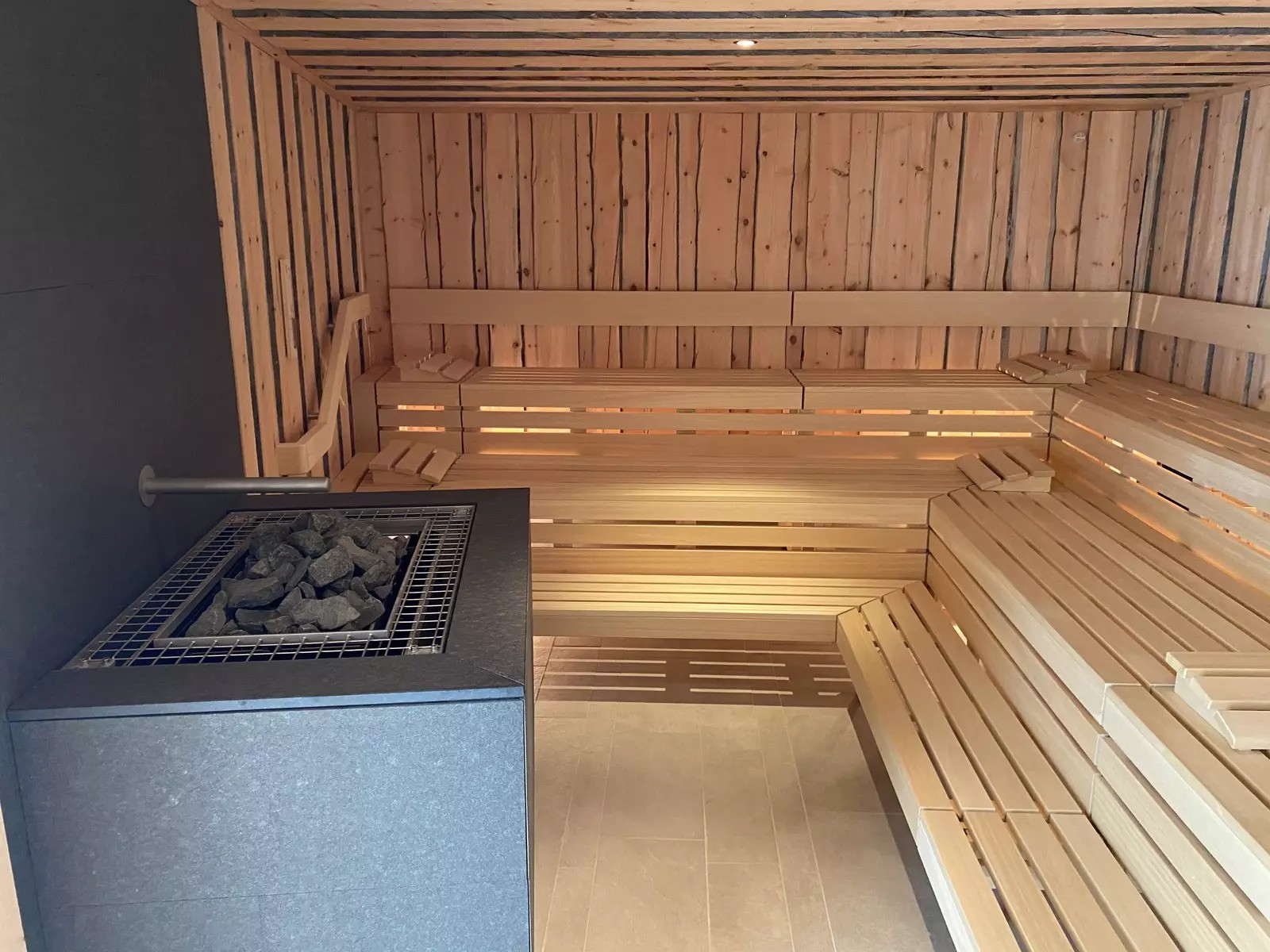
The city sits on one of Europe’s largest mineral water reserves, which means soothing, mineral-rich pools are practically a local pastime. For a dose of relaxation after pounding Stuttgart’s streets, the spas - many equipped with pools, steam rooms and saunas - offer exactly what you didn’t know you needed.
Here are the highlights to help you plan your spa escape (ideally with better time management than mine):
- DAS Leuze Mineralbad: A local favourite with both indoor and outdoor thermal pools.
- Mineral-Bad Berg: Intimate and old-school, with a focus on traditional mineral bathing. The atmosphere here is restorative.
- SchwabenQuellen: A “world spa” experience that feels part tropical paradise, part global adventure. Think themed saunas, relaxation zones, and pools inspired by cultures around the globe.
- Solebad Cannstatt: This is the spot to ease tension and let your muscles melt into bliss, with pools, steam rooms and sauna all being fed by five mineral springs.
- Panorama Therme Beuren: Located just outside Stuttgart, 1 hour southeast by train, it’s a scenic gem. Indoor and outdoor pools paired with beautiful hillside views make it feel like a little retreat.
- Mineraltherme Böblingen: Modern and clean — ideal for those seeking a no-fuss wellness experience with multiple thermal pools and saunas. 20 minutes southwest of Stuttgart on the S-Banh green (S1) line.
- Therme Bad Wildbad (Palais Thermal): A day trip west of Stuttgart brings you here — an ornate, historical spa that drips with luxury and old-world grandeur. 1.20 hour by train west of the city.
Reality Check: A third day in Stuttgart (or simply better planning) would’ve been needed to fully soak in more than just one of these options. The thermal baths are scattered around the city and just beyond it, so dedicating a day to spa-hopping — or choosing just a couple of standouts — is the way to go.
Pro Tip: Check opening hours in advance and aim for earlier in the day to beat the crowds.
For a city that can feel heavy on museums and automotive history, Stuttgart’s thermal baths are an unexpected delight. Give yourself the time to soak, unwind, and embrace the slow life. You’ll thank yourself later.
Save this article for future reference!
A 2-3 Day Stuttgart Itinerary
Now that you’ve got the lowdown on Stuttgart’s highlights, it’s time to turn those scattered sights into a strategic plan. Whether you’re here for a weekend or squeezing it in between bigger destinations, this itinerary provides a balance of palaces, parks, museums, and maybe a spa or two.
2-3 Day Stuttgart Itinerary Overview
Day 1
- Schlossplatz, the New Palace (Neues Schloss), Middle Palace Garden
- Schillerplatz and Stiftskirche
- Markthalle
- Kunstmuseum
- Königstraße
- Weissenhof Estate
- Killesberg Park
- Bohnenviertel District
Day 2
- Mercedes-Benz Museum
- Pig Museum
- Grabkapelle auf dem Württemberg
- Staatsgalerie Stuttgart
- Stuttgart Public Library
Day 3
- DAS Leuze Mineralbad or Mineralbad Cannstatt
- Stuttgart’s Vineyards
- Panorama Therme Beuren or Mineraltherme Böblingen
Detailed Itinerary: Exploring Stuttgart in 2-3 Days
Dive into a carefully crafted 2-3 day itinerary that takes you through Stuttgart's history, modern charm, and relaxing escapes.
Day 1 – Palaces, Squares, and the City Core
9:00 AM – Start at Schlossplatz and the New Palace (Neues Schloss)
- Begin your day at Stuttgart’s beating heart. Stroll the square, admire the baroque palace, and sip a coffee as the city wakes up.
10:30 AM – Wander the Middle Palace Garden
- Just behind Schlossplatz, this peaceful green space is perfect for a morning walk or a quiet breather.
11:00 AM – Explore Schillerplatz and Stiftskirche
- Step back in time at this charming square and peek inside Stuttgart’s oldest church. The nearby flower market (on Saturdays) adds an extra splash of colour.
12:00 PM – Lunch at Markthalle Stuttgart
- Wander through this foodie paradise and grab a fresh snack — something local, something sweet, or both.
1:30 PM – Visit the Kunstmuseum Stuttgart (optional)
- If you’re into contemporary art, spend an hour exploring this glass cube’s bold collection. Otherwise, ...
2:30 PM – Stroll Königstraße
- Take a walk down Stuttgart’s main shopping street. Stop for a pastry or two — you’ve earned it.
3:30 PM – Explore the Weissenhof Estate (Weissenhofsiedlung)
- Hop on bus 44 (from Stuttgart Central Station) to this UNESCO-listed collection of modernist and Bauhaus architecture. Rain or shine, it’s a fascinating stroll through design history.
4:30 PM – Wander around Killesberg Park
- Enjoy this green oasis. Climb up the Killesberg Tower for the views, wander through the green spaces, then grab a drink at Höhencafe Killesberg.
6:00 PM – Dinner in the Bohnenviertel District
- Take a bus back to the centre and end your day in Stuttgart’s oldest quarter. The cosy streets are perfect for a meal in a local spot, such as Weinstube Stetter - Weinhandel & Weinstube.
Day 2 – Cars, Architecture, and a Little Quirk
9:00 AM – Dive into the Mercedes-Benz Museum
- A short train ride northeast of the city centre takes you to Stuttgart’s automotive crown jewel. Allow 2-3 hours to explore this masterclass in design and storytelling.
12:00 PM – Quick Stop at the Stuttgart Pig Museum
- A nearby curiosity for those who like the offbeat — this quirky spot is as fun as it is bizarre. You'll need to walk southwest across the Neckar River for 25 minutes from the Mercedes-Benz Museum to get here.
1:30 PM – Grabkapelle auf dem Württemberg
- Take a 30-minute bus trip (N6 and RT6) further northeast to this hilltop chapel surrounded by vineyards. Pack a snack and enjoy sweeping views of Stuttgart and the Neckar Valley.
4:00 PM - Visit Staatsgalerie Stuttgart (Stuttgart State Gallery)
- Explore a renowned art museum, home to masterpieces spanning from classical to modern art. The building itself is a blend of historic and contemporary architecture, making it a visual treat inside and out. It's a 45-minute journey by bus (N7) and U-Bahn (U4) back to the city centre for the gallery from Grabkapelle auf dem Württemberg. Note: The gallery closes at 5:00 PM most days.
5:00 PM – Optional Stop: Stuttgart Public Library
- If you have time, make a quick visit to this modern, photo-worthy cube — it’s free to enter and stunning at sunset. Don't forget a trip to the top floor!
7:00 PM – Return to Königstraße or the area around Stiftskirche for dinner and drinks
Day 3 – History and Relaxation
9:00 AM – Unwind at DAS Leuze Mineralbad or Solebad Cannstatt
- Dedicate your morning to Stuttgart’s thermal waters. Soak in mineral-rich pools and embrace a slower pace.
12:00 PM – Lunch in a Local Café or Grab a Snack to Go.
1:30 PM – Discover Stuttgart’s Vineyards
- Head northeast of the city to explore wineries or vineyards like Weingut Karl Haidle, Weingut Aldinger, or Schnaitmann (check opening times in advance). Even if the tasting rooms are closed, the vineyard walks and views are worth the effort (if it's not raining).
4:00 PM – Scenic End at Panorama Therme Beuren (open until 10:00 PM) or Mineraltherme Böblingen (open until 10:00 PM)
- If time allows, take a trip out of the city to one of these stunning thermal spas for the ultimate relaxation finale. Perfect for sore feet and tired minds. A private transfer would be advisable, especially for Panorama Therme Beuren - multiple transfers between train and bus are needed.
- If you want a real treat, head to Therme Bad Wildbad (Palais Thermal) - take private transport as the trip by train is 1 hour+, one-way, and it's only open until 10:00 PM.
Flexible Add-Ons
If you’re short on time or want to swap things around, consider:
- Skipping smaller stops like the Pig Museum or Public Library;
- Choosing either the Mercedes-Benz Museum or Porsche Museum; or
- Prioritising thermal spas for a third-day reset — they’re Stuttgart’s quiet standout.
Essential Information for Visiting Stuttgart
Before diving into Stuttgart’s quirks and highlights, it helps to have the basics down. From the best times to visit to navigating the city like a local, here are some things you need to make your trip smooth.
Best Time to Visit Stuttgart
Stuttgart is a year-round destination, but let’s be honest — if you’re not a fan of grey skies and drizzle, you might want to time your visit carefully. Spring (April to May) and autumn/fall (September to October) are the sweet spots, with mild weather, blooming vineyards, and enough sunshine to remind you it’s not perpetually cloudy here.
Summer (June to August) offers long days and lively festivals, but you’ll have to dodge the occasional rainstorm (pack an umbrella or poncho — you’ll thank me later). Winter (November to February) is chilly and quieter, but the city’s Christmas markets are worth braving the cold for. Just don’t expect Stuttgart to sparkle like a winter wonderland — this is more “festive functional” than “storybook magic.”
In short, Stuttgart won’t blind you with sunshine, but it’ll charm you in its own slightly overcast way. Bring layers, an umbrella or poncho, and low expectations for the weather, and you’ll be fine.
Getting Around Stuttgart
Stuttgart is compact enough to explore easily but big enough to keep you on your toes when it comes to transportation. Whether you’re a fan of walking, hopping on public transport, or getting a bit adventurous, here’s how to navigate the city without getting too lost.
On Foot
The city centre is walkable, with most major attractions — like Schlossplatz, Königstraße, and the Markthalle — within strolling distance of each other.
Just be warned: Stuttgart has hills. Lots of them. You might start your day feeling smug about skipping leg day, but by the afternoon, you’ll understand why locals take their stairways seriously.
By U-Bahn, S-Bahn and Bus
Stuttgart’s U-Bahn (metro), S-Bahn (suburban trains), and buses make getting around the city and its outskirts a breeze. Day passes are affordable and worth it if you’re museum-hopping or venturing to spots like the Mercedes-Benz Museum or Killesberg Park.
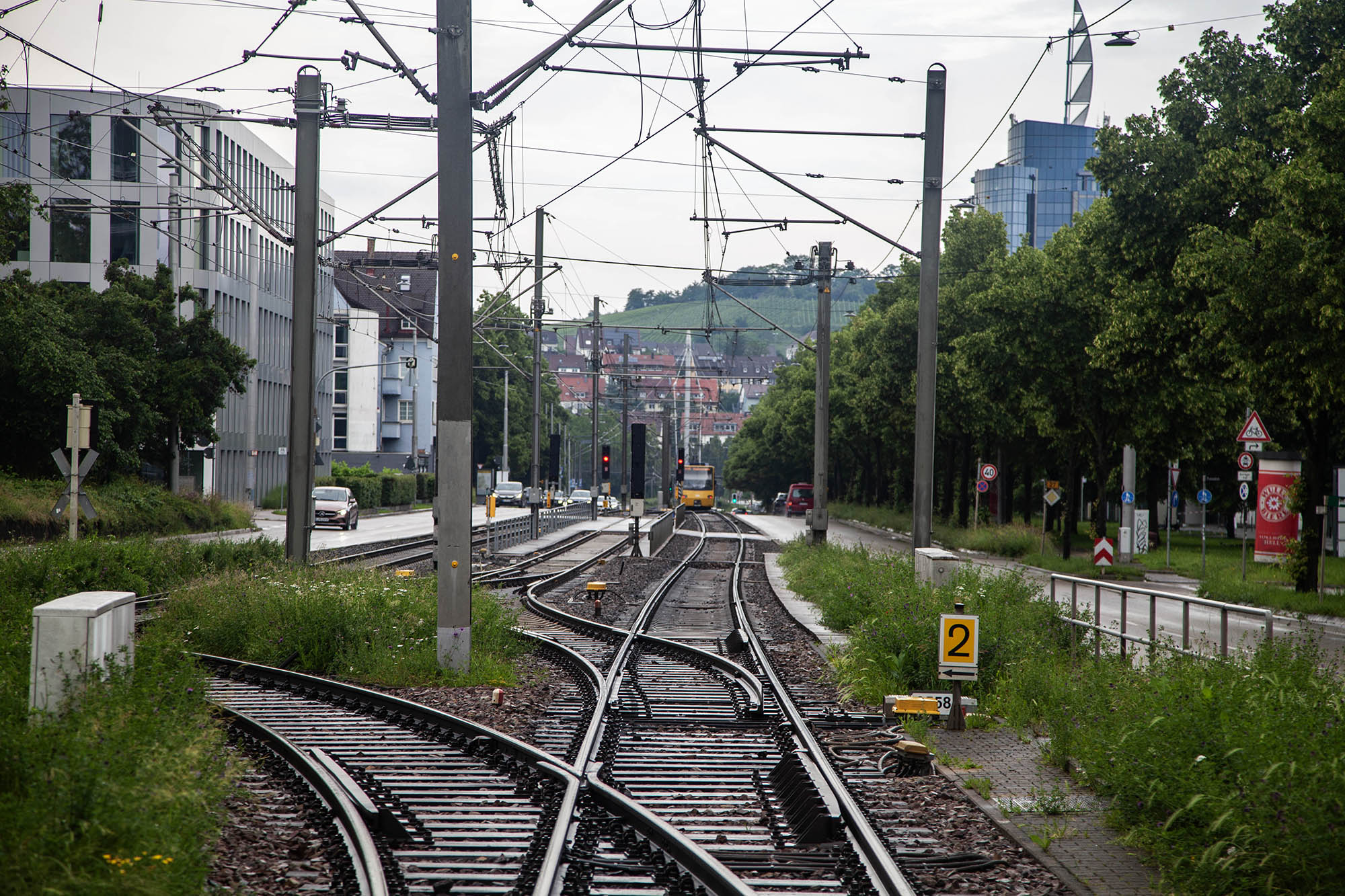
Bonus: the transport system is mostly on time (or at least it was during my stay), efficient, and as German as you’d expect.
By Bike or Scooter
Feeling eco-friendly? Stuttgart’s bike-sharing schemes and electric scooters are a fun way to zip around town. Just remember, those hills aren’t kidding — what seems like a breezy ride downhill could turn into a thigh-burning ordeal on the way back.
By Car
Unless you’re a masochist who loves navigating narrow streets and paying for overpriced parking, skip renting a car in Stuttgart. Public transport is easier, and the city centre isn’t car-friendly. However, if you’re planning to explore vineyards or thermal spas far beyond the city, a car will come in handy.
Stuttgart might not be Berlin with its hipster bikes or Munich with its polished trams, but it gets the job done. Just plan your route, embrace the hills, and remember: if all else fails, there’s always the trusty U-Bahn.
Getting to Stuttgart
Stuttgart is conveniently located in southwestern Germany, making it easy to reach by train, plane, or even car (if you’re feeling adventurous). Whether you’re arriving from within Germany or further afield, here’s how to make your grand entrance into the land of cars and vineyards.
By Plane
Flying into Stuttgart Airport is easy, with regular connections from major European cities and beyond. The airport is about 30 minutes from the city centre via the S-Bahn (line S2). It’s functional, efficient, and everything you’d expect from a German airport — just don’t expect it to wow you with charm.
By Train
Stuttgart’s Hauptbahnhof (main train station) is a major hub, so arriving by train is as smooth as a freshly waxed Mercedes. High-speed ICE trains connect the city to Munich (around 2.5 hours), Frankfurt (1.5 hours), and Berlin (5-6 hours).
Regional trains are perfect if you’re coming from smaller nearby towns (or using the Deutschland Ticket, as I was - a 10-hour journey from Zittau, Saxony!).
Bonus points: the station’s central location means you can step off the train and dive straight into the action.
By Bus
Long-distance buses are a budget-friendly option, with companies like FlixBus offering routes from major cities. The downside? The journey can be slow.
But hey, you’ll save some cash, and isn’t that what really matters?
By Car
If you’re road-tripping, Stuttgart is well-connected by the Autobahn. Be prepared for fast drivers, confusing junctions, and the occasional roadwork because, of course, Germany loves a good construction project.
Parking in the city can be a hassle, but if you’re heading to vineyards or surrounding areas, having a car is worth it. Just don’t forget to check if your rental has GPS — or better yet, download an offline map and pray for no signal issues.
Pro Tips for Arrival
- If you’re coming in by train or plane, consider grabbing a day pass for public transport — it’ll save you money and stress.
- Pack light: Stuttgart’s hills will punish anyone with an oversized piece of luggage.
- And remember, arriving in Stuttgart isn’t about flashy first impressions — it’s about getting here efficiently and then letting the city surprise you.
No matter how you get to Stuttgart, just know that all roads (and railways, and flights) lead to wine, cars, and a city that’s quietly worth the journey.
Where to Stay in Stuttgart: Budget to Luxury Options
Whether you’re a budget backpacker, a mid-range traveller, or someone who likes their hotel stays with a side of luxury, Stuttgart offers plenty of options. Here’s a breakdown to help you find the perfect spot, from no-frills hostels to chic five-star stays.
Budget: a&o Hostel Stuttgart City
For budget travellers, a&o Hostel Stuttgart City is a solid choice. I stayed here and was pleasantly surprised.
There friendly staff made the check-in process smooth. Clean dorms with decent beds and good shared facilities made my stay comfortable. And being well-connected to public transport and close enough to the city centre made sightseeing easy.
It ticks all the right budget boxes. It's perfect for budget-conscious travellers who value cleanliness and convenience over frills.
Mid-Range: Premier Inn Stuttgart City
For a reliable and modern mid-range stay, the Premier Inn Stuttgart City Europaviertel offers comfort and convenience. There are bright, well-designed rooms with plush beds and modern amenities. Plus it's close to Stuttgart’s city centre and public transport, making it a great base for exploring.
It’s a great choice for those seeking a hassle-free stay in a clean and friendly environment, all at a somewhat affordable price point - it does teeter on the lower end of high-end prices. Plus, the Premier Inn is known for its consistency, so you can rest easy knowing what to expect.
Pro Tip: Book early during peak times like Christmas markets or the Stuttgart Beer Festival for the best rates.
High-End: Le Méridien Stuttgart
For travellers seeking luxury, elegance, and a touch of indulgence, Le Méridien Stuttgart is Stuttgart’s premier five-star escape. It offers spacious, beautifully decorated rooms with plush bedding and high-end amenities. And there a world-class wellness centre featuring a spa, indoor pool, and fitness facilities.
Located across from the Schlossgarten park and a short walk from the city centre, it’s ideal for those who want to combine relaxation with convenience. Whether you’re in town for business or a special occasion, Le Méridien delivers a luxurious experience.
Pro Tip: Treat yourself to a room with park views for a serene start to your mornings. Perfect for travellers who want to splurge in style.
Language Used in Stuttgart, Germany
In Stuttgart, the official language is, unsurprisingly, German — but don’t let that intimidate you. Like most major cities in Germany, Stuttgart is friendly to English speakers, especially in tourist areas, restaurants, and museums.
The local dialect, Schwäbisch, adds a unique twist to standard German and might catch your ear with its singsong intonations and quirky words. While you probably won’t need to learn Schwäbisch (unless you’re planning to charm a local), it’s fun to know that Stuttgart has its own linguistic flair.
Pro Tip: A few polite German phrases go a long way. Try these:
- Hallo (Hello)
- Bitte (Please)
- Danke (Thank you)
- Entschuldigung (Excuse me)
Most locals, especially younger generations, speak enough English to help with directions or recommendations. However, stepping into smaller neighbourhoods or more traditional spots like vineyards might mean relying on your best pantomime skills — or Google Translate.
In short, Stuttgart won’t leave you lost in translation, but throwing in a few German words is always a good idea. Bonus points for attempting a Schwäbisch “Grüß Gott” — just don’t expect to nail the pronunciation.
FAQs About Visiting Stuttgart
Stuttgart might not be at the top of your travel bucket list, but it’s full of surprises — and questions. From where to find the best thermal bath to whether you’ll survive the hills (spoiler: you will), here are answers to some of the most pressing and oddly specific queries about visiting this unique German city.
What is Stuttgart best known for?
Stuttgart is the kind of city that likes to keep you guessing. Ask most people, and they’ll say cars and wine, which feels like a contradiction until you’re here. It’s the birthplace of the automobile — home to the sleek Mercedes-Benz and Porsche museums — but it’s also surrounded by rolling vineyards that produce some of Germany’s quirkiest wines (hello, Trollinger).
Beyond that, Stuttgart boasts stunning palaces, mineral-rich thermal baths, and hills so steep you’ll feel like you’re climbing a rollercoaster. Add in a knack for understated charm, and you’ve got a city that’s quietly iconic — just don’t expect it to shout about it.
How many days are needed in Stuttgart?
Stuttgart isn’t the kind of place that demands a week of your life, but it’s worth more than a rushed day trip. 2-3 days hits the sweet spot, giving you time to explore its palaces, dive into its automotive history, wander the vineyards, and soak in a thermal bath (because let’s be real, you’ll need one after tackling those hills).
If you’re a museum fanatic or want to fit in day trips to nearby towns, you could stretch it to four days. But any longer, and you might start feeling like you’ve overstayed your welcome — Stuttgart knows how to charm, but it doesn’t overstay its own party.
Which are the best museums in Stuttgart?
Stuttgart doesn’t mess around when it comes to museums — it’s got something for everyone, whether you’re into art, history, or fast cars. Here are the must-sees:
- Mercedes-Benz Museum: A sleek, spiralling journey through over 130 years of automotive history. Even if you’re not a car enthusiast, this one’s a showstopper.
- Porsche Museum: Smaller but just as stylish, showcasing the evolution of one of the world’s most iconic car brands.
- Staatsgalerie Stuttgart: A treasure trove of art spanning centuries, from Old Masters to modern works in a bold pink-and-teal building.
- Kunstmuseum Stuttgart: A striking glass cube housing contemporary art and thought-provoking exhibitions.
- Pig Museum: Yes, it’s real, and yes, it’s exactly what it sounds like — a quirky collection of all things pig-related, from toys to artwork.
Whether you’re here for the culture, the cars, or the pure novelty, Stuttgart’s museums offer a little bit of everything. Just pace yourself — museum fatigue is real, and Stuttgart delivers it in style.
Are the thermal baths in Stuttgart worth it?
Absolutely — if you’re into soaking your stress away in mineral-rich waters while pretending you’re royalty, Stuttgart’s thermal baths are 100% worth it. The city sits atop one of Europe’s largest mineral water reserves, and the baths are a perfect mix of relaxation and wellness.
Options range from DAS Leuze Mineralbad, popular for its variety of indoor and outdoor pools, to the more intimate Mineral-Bad Berg, where tranquility reigns. If you’re feeling adventurous, head to SchwabenQuellen, a global-themed spa with saunas and pools inspired by international wellness traditions.
These baths aren’t just about relaxation — they’re a cultural experience, too. Locals take their spa time seriously, so be ready to embrace the slow life (and yes, lots of nudity in the sauna). If you have a free morning or afternoon, it’s the perfect way to unwind — especially if you’ve been braving Stuttgart’s hills.
Pro Tip: Visit early or on a weekday to avoid crowds, and bring flip-flops and a towel for the full experience. It’s Stuttgart’s quiet luxury, and you’ll leave wondering why you don’t spa more often.
Is Stuttgart walkable?
Yes … but Stuttgart makes you earn it. The city centre is compact and easy to explore on foot, with major sights like Schlossplatz, Königstraße, and the Markthalle within a short stroll of each other. But then there are the hills — oh, the hills.
I remember walking part-way up to Killesberg Park on a drizzly day, thinking I’d take the “scenic route.” By the time I got there, I wasn’t admiring the view — I was bargaining with my calves to keep moving. And just as the rain turned to a proper downpour, I discovered Stuttgart’s secret weapon: well-placed bus shelters for moments like this.
The verdict? Stuttgart is walkable if you’re game for a bit of a workout (and aren’t too proud to pause halfway up). For the truly steep climbs, there’s always public transport, but sometimes tackling a hill on foot is part of the adventure. Just pack comfortable shoes, embrace the drizzle, and reward yourself with a hot chocolate or wine at the end.
Is Stuttgart worth visiting?
It depends on what you’re looking for — but if you like cities that quietly surprise you, then yes, Stuttgart is worth visiting. It’s not as flashy as Berlin, as storybook-pretty as Heidelberg, or as polished as Munich, but that’s part of its charm.
What Stuttgart lacks in obvious showstoppers, it makes up for with quirky, understated gems: world-class car museums, sprawling vineyards on the city’s edge, thermal baths that feel like a hidden luxury, and a cultural scene that rewards those willing to look past its businesslike exterior.
Sure, the weather can be moody, the hills are relentless, and it doesn’t scream “tourist hotspot.” But if you’re open to a city that blends modernity, history, and a quiet kind of charm, Stuttgart will surprise you in the best way.
It’s a place where you can enjoy life’s simple pleasures — wine, spas, and good company — without the crowds or the hype.
Worth it? I’d say yes.
Save this article for future reference!
Reflections on Things to Do in Stuttgart
Stuttgart isn’t the kind of city that overwhelms you with postcard-perfect sights or a laundry list of must-sees, but that’s what makes it refreshing. It’s a city that reveals itself slowly, rewarding curiosity and patience.
From the grand palaces and quirky museums to the hills that challenge your stamina and the thermal baths that soothe your soul, Stuttgart is full of contrasts that keep it interesting.
It might not be the top pick on a German travel itinerary, but that’s precisely why it works. It’s a city where you can sip wine in the shadow of a vineyard, geek out over automotive history, and end your day soaking in mineral-rich pools — all without fighting through the crowds.
If you like your travel experiences a little offbeat, with a mix of luxury and local charm, Stuttgart is quietly unforgettable.
